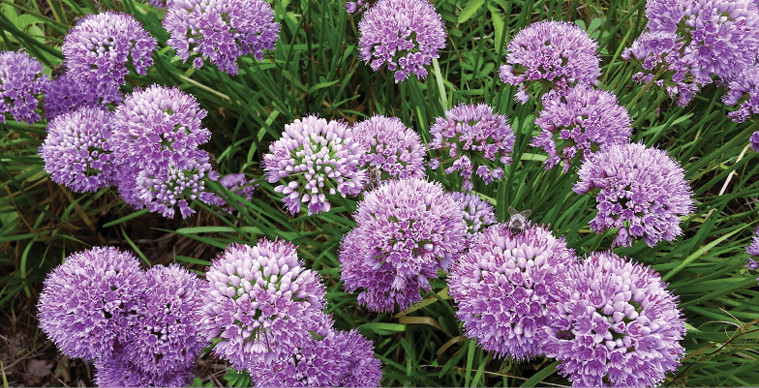

When thinking about drought tolerance in the garden and landscape, I know most gardeners' thoughts turn immediately to ornamental grasses, succulents, or other water-saving natives. My thoughts, however, more often turn to bulbs.
Gardening in a very tough Texas climate, not to mention less than cooperative soils, bulbs are some of my most dependable and drought tolerant performers. Those that also offer an edible component, such as chives, are that much more worth their allotted garden real estate.
Got chives?
My clumps of garlic chives, Allium tuberosum, are in fact the easiest to grow, most useful — and beautiful — blooming perennials, especially during the hottest and driest months here in Texas. They even thrive in our heavy clay soils.
During August, when most garden plants are just trying to hold down the fort until October, my garlic chives explode into masses of fluffy white blooms, right next to my huge concrete oven of a driveway. Their floriferous clumps sway and buzz with a bounty of incredibly happy pollinators in search of anything able to continue flowering and producing nectar during intense periods of heat and drought.
Fall is the best time to plant Allium bulbs of certain types, but potted specimens can be planted any time during your growing season. Chives, of course, form more of a dense matted root system rather than bulbs, with garlic chives being slightly more bulbous, so they’re an excellent season-long potted perennial for sales. In fact, I find the clumping types of Allium even easier to grow in the landscape than the larger bulb types and excellent long term container plantings.

Crowd pleasers
I’m a huge fan of Allium spp. in general and feel that some of the cultivars make for incredibly showy specimens in cultivated landscapes. Considering their ease of care and reliability under less than desirable conditions, I’m surprised they aren’t used more in managed commercial landscapes, as well as more often in residential gardens.
Allium ‘Millenium’ was my nomination as a board trustee for the Perennial Plant Association Plant of the Year for 2018; the membership agreed as it won the PPOY title that year. This cultivar produces masses of dense rosy-purple flowers during the heat of the summer and is just as happy growing in Michigan as it is in Texas, not an easy feat for many perennials.
In general, Allium are all drought tolerant plants that thrive when grown on the dry side. Plants love direct hot sunlight and are highly tolerant of reflected heat from hard surfaces such as concrete. Pest and diseases rarely impact plants and since deer aren’t partial to the flavor you won’t have to worry about them munching your plants. Bees and other pollinators, on the other hand, are quite content to have them as a food source.

Extended family
A member of the lily family, Allium is one of the largest plant genera, containing about 1,100 species — all edible — and there is a bounty of showy cultivars to choose from. Members of the lily family, chives (A. schoenoprasum), garlic chives, and other species, varieties, and cultivars of Allium represent a highly adaptable and resilient group of flowering perennials. In addition to chives and A. ‘Millenium’, I also adore A. sphaerocephalon, A. ‘Purple Sensation’ A. thunbergii ‘Ozawa’, and A. ‘Windy City’ to name a few.
Now, certain species will of course “naturalize” a bit more assertively than others. Chives and garlic chives will multiply by clumping and seeds, so you can often end up with a larger population than you originally intended. But if you are maintaining an area that needs to be self-sustaining, and you can tolerate some spreading, then chives are a great option. If you want to offer a sterile option that won’t spread, then go for A. schoenoprasum ‘Sterile’ Profusion.
Hold the water
While water availability may not be a present concern in wetter parts of the country, it’s a top priority for those of us in drier states. And it should be a present concern for all of us globally, no matter where we live, even if our local region is considered “wet.” Getting the most out of our garden plants in terms of food sources both for people and our local wildlife, and long-term resiliency with low inputs, is no longer negotiable.
It’s not easy to check all desired boxes with just one plant. But if you want to expand your selection of drought-tolerant, heat-tolerant, pest and deer resistant, pollinator-friendly, edible perennials, then a deep dig into the genus Allium is in order!

Explore the April 2022 Issue
Check out more from this issue and find you next story to read.
Latest from Greenhouse Management
- Landmark Plastic celebrates 40 years
- CropLife applauds introduction of Miscellaneous Tariff Bill
- Greenhouse 101 starts June 3
- Proven Winners introduces more than 100 new varieties for 2025
- UF/IFAS researchers work to make beer hops a Florida crop
- CIOPORA appoints Micaela Filippo as vice secretary-general
- Passion grows progress
- Registration opens for Darwin Perennials Day





